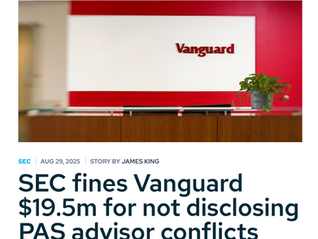- Rubin Miller, CFA

- Apr 10
- 3 min read
When it comes to investing, it's not that hard to make money most of the time.
But the nondescript phrase — make money — is nuanced to the extreme detriment of people who think it's without risk or reliable. In reality, if you own stocks, you are always taking risk, and thankfully most of the time investors have been rewarded for that.
Generally speaking, as relates to stocks (using the S&P 500):
Stocks are up about 52% of days.
Stocks are up about 70% of years.
Stocks are up about 94% of decades.
Knowing this, why is it so stressful for investors to stay investors?
Because stock markets eat like an ant, but shit like an elephant.

As the percentages of time markets are positive insinuate, we tend to creep higher slowly (like ants).
Then, as the right side of the chart insinuates, the elephant shits...
We lost over 10%, which is the average positive return ANNUALLY, in just two days!

Investors get frustrated because it feels easy to make money buying stocks, until it isn't.
And they're not wrong. It IS easy to make money buying stocks if you look at it on a frequency scale.
But the system skews. Magnitude matters.
You can make a little money most of the time, but you risk losing a lot of money a little of the time.
It's always been this way. Thankfully, the wipeouts only feel like wipeouts: the average positive return of the S&P 500 (again, about 10% per year) includes the wipeouts.
Alas, yesterday, the elephant seems to have flipped on its head and shat upward — as the S&P 500 rallied 10% in one day.

You just don't see it that often! And note how April 3-4 are deep in the left (negative) tail while yesterday, April 8, is deep in the right tail...that's also a function of the system: the best and worst days have always historically clustered together, and while there are more devastating negative days than exhilarating positive days, the ant marching has overcome that distribution issue.
Diversified stock portfolios have positive historical returns, but realizing those gains can be excruciating because of periods like right now.
Humans hate big losses, and that can cause unforced errors like exiting the market after a large drop.
And what fascinates me about yesterday is that one man can make one decision and we have a nearly 10-sigma event impacting the financial livelihoods of billions of people around the globe. It feels uniquely Trumpian.
Here is what Greg Ip writes this morning in the WSJ:
In recent years, the U.S. has boasted faster growth, bigger advances in technology, and more-ample supplies of cheap energy than almost any other major economy. Investors worldwide flocked to “American exceptionalism” by buying its assets.
The U.S. is still exceptional, but it is also less predictable, more antagonistic, and more isolated.
This isn't a political blog, so I'm less interested in discussing the antagonism and isolationism as I am the unpredictability.
Stock market prices are brutish and irreverent. Just this past week we lost 10%+ in two days as Trump incepted a tariff war.
Take heed: MARKETS ARE WORKING. Their job is to incorporate new information into prices.
Stock market prices are brutish and irreverent. Just this past week we gained 10% in one day as Trump walked back a tariff war.
Take heed: MARKETS ARE WORKING. Their job is to incorporate new information into prices.
Consider Trump's unpredictability relative to other administrations. You may like or not like it politically, but stock prices don't care about your opinions (let them tell you what they think).
That's a good thing, by the way — prices will constantly adjust to our new economic and political environment (recently quite stressful, if I do say).
What we saw yesterday is that Trump can be unpredictable to the upside as well.
I expect continued jitters and whippiness in the markets, and will not deviate from my evidence-based principles. I won't try to outguess prices.
But I am changing my opinions about the expected nature of the elephant and the ant.

I think given the president's temperament and approach to decision-making, we will see the elephant shitting a lot more. But I also think he now shits upward quite a bit. We have a president with volatile policy-making patterns who has now shown he 's willing to backtrack on them. Markets have already shown us they will react accordingly.
When we look back, I'm sure we will have had some ant-periods during this second Trump era. But for the foreseeable future, it's elephants. To the up and to the down.
Welcome to the grasslands.
Hope you have a portfolio you can stick with.
End.








